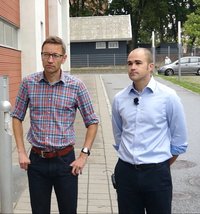INDR editorial, October 2017

Vibrancy within the INDR
Editorial by John Gleaves and Ask Vest Christiansen
Nothing could be further from our minds than self-praise. Then again. We must acknowledge that the INDR conference in August once more demonstrated the importance and significance of the work of INDR scholars. Even if this conference may be small in terms of absolute numbers of participants, quite a few delegates approached us to say how it, unlike most other conferences, is characterised by an unusual high percentage of quality papers. For the parallel sessions, the problem is not to find out what to hear, but to negotiate what to miss. While this is in itself reassuring, at the same time it indicates that the research and expertise of INDR members will continue to be a requested resource in the future. It is thus no coincidence that scholars associated with the INDR were heavily quoted in major contributions that has come out the last two years. This has for instance been the case with the “McLaren report” – WADA investigation of Sochi allegations, the Cycling independent reform commission report, the United States vs Lance Armstrong et al. – Expert Witness Report, as well as countless media interviews, working groups, and policy consulting (including EU and US). As we demonstrated in our opening address, with an excerpt from the documentary ICARUS on the death of former RUSADA CEO Nikita Kamaev, our work sometimes also connects with broader political issues in different and quite disturbing ways. Taken together these examples accentuate that the work from scholars of this network puts a mark out there. It matters and others will use our research. This is encouraging.
New(ish) Prevalence Study
Also in August, Ulrich et al. finally published their 2011 study of doping prevalence at two International Association of Athletics Federation meets (Ulrich et al., 2017). While politics and intrigue have surrounded this study, its publication has finally let researchers see not only the estimates gathered in the study but also its methodology. The research team utilized the “Randomized Response Technique,” which is an established social science survey for inquiring about sensitive information. In this case, randomization was secured by asking participants to think of a person close to them whose date of birth they knew. Then, if this date fell between the 1st and 10th day of the month, the participant was asked to answer a non-sensitive question. However, if the chosen person’s birth date fell between the 11th and 31st day of the month, the participant was asked to answer the sensitive question: ‘‘Have you knowingly violated anti-doping regulations by using a prohibited substance or method in the last 12 months?’’ The results showed that 43.6% (with a 95% confidence interval between 39.4–47.9) at World Championships in Athletics and 57.1% (with a 95% confidence interval between 52.4–61.8) at the Pan-Arab Games admitted to having done so.
Compared to many other studies on doping prevalence, these numbers are high. There appears to be three possible explanations for this: 1) All of the previous studies underestimated doping prevalence; 2) Doping is increasing; or 3) This study has a flaw that overestimates prevalence.
While the first two points are interesting, let us consider the third point. Having looked through the study’s methods, a few assumptions jump out. First, the study assumes that athletes who are doping would have a reason to lie about their doping to avoid punishment or social disapproval. Second, the study assumes that given anonymity, athletes will answer honestly. Third, that athletes will understand the study’s method to protect their anonymity.
If athletes did not understand their responses would be anonymous, they would have reason to lie about their doping. However, this would lead to a lower number rather than a higher one. However, what if athletes did not want to answer honestly? The only way this would over inflate the numbers is if athletes that were not doping decided to lie and say they were doping. One potential reason an athlete might do this would be suspicion that their opponents were doping and the belief that over reporting would bring increased anti-doping surveillance to catch their doped opponents. That is certainly playing the “long game” and would require many athletes to collude or independently arrive at the same conclusion.
A second possibility is that many athletes chose to answer the non-sensitive question. Since researchers would have no way of knowing which question the athletes should be answering, athletes could simply change their mind and imagine a birthday that allowed them to avoid answering the doping question. It would be hard to imagine why athletes that did not dope would wish to avoid the question about doping so it would mean only doped athletes switched to answer the non-sensitive question. So it is hard to see how this would bias the outcome of the study upwards since it would logically lead to more “no” answers rather than “yes” answers.
Even as researchers’ controlled for “fast responders” they showed that doping prevalence was still higher than many previous estimates reported (namely, 30 and 45 percent respectively for the two events). In the end, the study shows how much more research can be done and how vibrant the questions within doping research are.
References:
Ulrich, R., Pope, H. G., Jr., Cleret, L., Petroczi, A., Nepusz, T., Schaffer, J., . . . Simon, P. (2017). Doping in Two Elite Athletics Competitions Assessed by Randomized-Response Surveys. Sports Medicine. doi:10.1007/s40279-017-0765-4